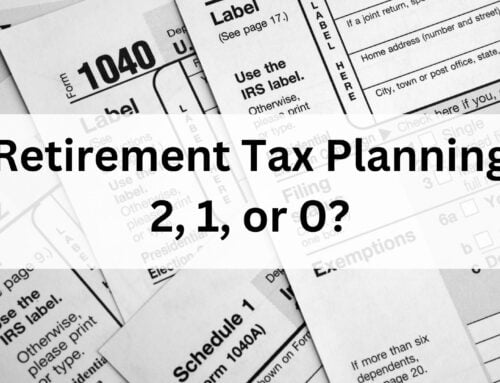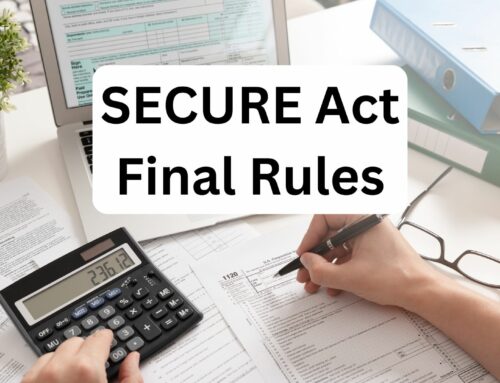Retirement Red Zone
The retirement red zone is the 5 years before and after retirement. This is the time when the sequence of portfolio returns is most important. The sequence of returns is the danger that losses in your portfolio early in retirement can reduce the amount you’ll be able to withdraw in the future. This early loss has long-term impacts on your retirement because you are also taking withdrawals from the account at that time.
Sequence of Return Risk Example:
You have 100 dollars you’re going to invest for 3 years. Your interest is going to be 20%, 10%, and -30%.
Sequence #1: 20%, 10%, -30%
End of Year 1: $120
End of Year 2: $132
End of Year 3: $92
Sequence #2: -30%, 10%, 20%
End of Year 1: $70
End of Year 2: $77
End of Year 3: $92
The order of the returns doesn’t matter. This is because you’re not adding or taking out money.
During retirement, we’re concerned about withdrawals. So, what happens if I need to take $10 out at the end of each year to live on?
Sequence #1: 20%, 10%, -30%
End of Year 1: $120 – 10 = $110
End of Year 2: $121 – 10 = $111
End of Year 3: $78 – 10 = $68 – If you add back the $30 you’ve taken out, you actually have more than the non-withdrawal scenario ($98 versus 92)
Sequence #2: -30%, 10%, 20%
End of Year 1: $70 – 10 = 60
End of Year 2: $66 – 10 = 56
End of Year 3: $67 – 10 = 57 – Adding back the $30, you’re now at $87 (less than the $92) example
The person who experienced a loss early has less money than the person who experienced a gain first. This is the sequence of returns risk.
So how do combat this mathematical reality and successfully navigate the retirement red zone? This is what retirement planning is all about. The first step is to decide on your notional withdrawal plan.
Build A Withdrawal Plan
It’s important to build a plan that will allow you to successfully withdraw the money you need to live on in retirement. There are several strategies commonly used strategies.
-
Bucket Strategy
You have short-term, medium-term, and long-term buckets that have investments aligned with their need. Short-term investments would be in cash, CDs, or short-term bonds and typically be able to cover 1-3 years of expenses. Medium-term would typically be a bond ladder that would roll over every year. Finally, the long-term bucket would be a mix of stocks and long-term investments. This bucketing allows you not to have to sell investments that may be temporarily down.
-
Guardrail Method
You set an initial withdrawal rate for your portfolio (say 5%). On a $1 million portfolio, that’s $50,000 per year. You will adjust that for inflation each year. Each year you calculate the percentage you’re withdrawing. If the percentage is between 4% and 6% of your portfolio nothing changes. If you’re portfolio drops so you’re taking a larger percentage (>6%), you’ll reduce your spending by about $45,000 for that year. If, on the other hand, the stock market is ripping and your portfolio has grown so you’re only taking 4% you get to increase your spending to $55,000.
-
Look-Through Portfolio with Guaranteed Income for Minimum Lifestyle Expenses
Instead of looking at the portfolio as a single pile of money to generate income, this method seeks to earmark portions for specific needs. The principle is you can only spend a dollar once so figuring out where they are needed gives you flexibility. You begin with determining your minimum lifestyle expenses (housing, healthcare, food, transportation) and building a plan to cover that with secure lifetime income (pension, Social Security, annuity, etc). After that, you set aside money for aging-related expenses (long-term care, things you’ll need help with or no longer want to do as you get older), any guaranteed inheritance or gifts you want to leave, and finally a buffer amount.
Whatever is leftover is your “fun number” [You can find a post on this here]. Money you can use to enjoy retirement. [H/T The Retirement & IRA Show podcast for their discussion of this concept] You manage each portion based time-frame needed and risk tolerance. I’ve become a big fan of this methodology and plan to write more about it in the future.
Knocked Off Track or Haven’t Saved Enough?
What else can you do if your plan gets knocked off track in the retirement red zone or you haven’t saved enough to even start retirement? There are numerous ways to recover. This could include working longer or part-time, saving more, and or cutting spending. Here are 5 things.
Reduce lifestyle creep
Most people’s highest earning years are those 5-10 years before retirement. Keeping your lifestyle in check means you’ll have less money you need to replace in retirement. Funneling that extra income into savings and not lifestyle gives 2 benefits; it’ll be available for retirement and you’ll need to replace a smaller amount of income.
Tax Smart Withdrawals
If you’ve saved across taxable, tax-deferred, and tax-free accounts while you were working you can optimize your withdrawal strategy to potentially reduce taxes. If you retire before starting Social Security you may also consider converting some tax-deferred savings into tax-free accounts to save on taxes in the long run.
Build guaranteed income streams
If you don’t have a pension, consider creating income streams using an annuity or other products. These can reduce anxiety allowing you to know you have your minimum expenses covered. Short-term products like a multi-year guaranteed annuity (MYGA) can also be used to bridge between early retirement and Social Security.
Plan to delay Social Security
In many, if not most, cases it’s better to delay Social Security as long as possible. This is true even if you must spend down investments early in retirement. There are too many different situations to summarize here, but this is one of the most financially impacting retirement decisions you’ll make.
Work longer
Working longer, or even just part-time, is one of the best ways to extend your retirement portfolio. It allows your portfolio to continue to grow and reduces the amount you need to take out at the same time. It may also increase the amount of Social Security you’ll get in the future.
Stress Test
Finally, one of the most important things you can do is stress test your plan. What are the things that could knock you off track? Some things to consider are the early death of one member of a couple, multi-year long-term care needs, longevity risk, or a multi-year bear market.
While this may seem rather gloomy, preparation is key. Many retirees, especially those with military or other pensions, find they actually have more money than they need or end up with more than they started with when they die. Having a plan for when things go better than expected is also important as the goal isn’t to die with it, it’s to use it while you’re alive (link).



